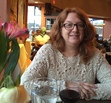K. Heidi Fishman's Blog, page 6
April 26, 2016
Terezín

I had a visceral reaction to Terezín. I’ve started this post several times over the last two weeks, and I can’t wrap my head around putting my reaction into words.
I found the town of Terezín (it is a town now) to be completely and utterly depressing. You might say to yourself – of course it was depressing, it was a concentration camp. Yes, that is part of it, but not all of it. There are people living in a town that was a concentration camp. The roads are the same. The buildings are the same. The windows are the same. People wake up and and shower and eat and work and live and make love and go about their lives in the same rooms where 140,000 suffered and 36,000 died and 88,000 were living just before being sent east for extermination. It is also depressing because of its current state of disrepair and economic stagnation. Both its past and its present are a sad scene. And I didn’t see much hope for its future either.
Maybe poetry and pictures are the only way to express myself this time.
Crumbling walls,
Broken glass,
Broken lives,
In Terezín.
Protective walls become the cage.
Banks with money
For empty stores
And a café without coffee.
Promises with no intention
But trickery.
A spa on the way to Auschwitz.
For the Jews of Theresienstadt.
Overcrowded and desolate.
Years of suffering then.
No hope now.

Ramparts and train track entering Terezin

Pile of rubble behind Dresden Barracks

Theresienstadt’s streets were identified by letters and numbers
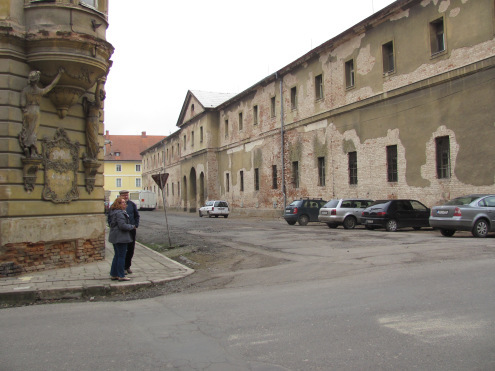
I’m standing with our guide looking at the remains of the Hannover barracks
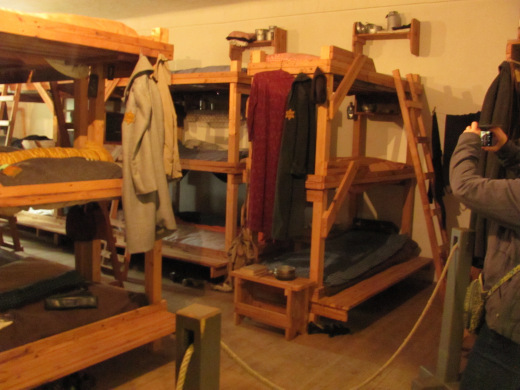
Museum display in the Magdeburg Barracks showing a typical room in Theresienstadt. My mother thought the display was accurate, except that it looked too new and clean, and not crowded enough.
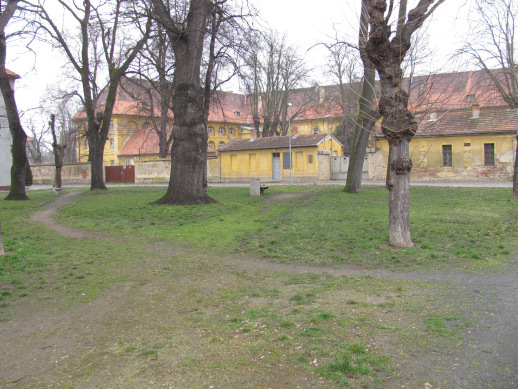
Remains of the hospital where my mother worked as a messenger when she was nine.
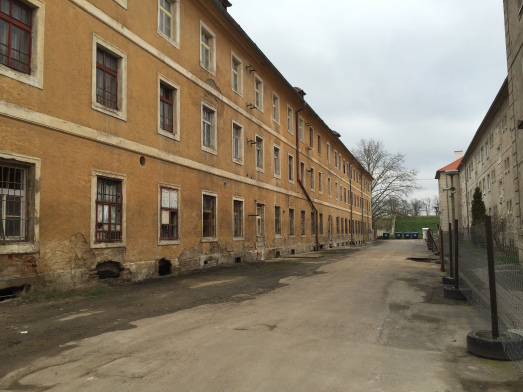
Remains of Dresden barracks which housed mothers and children. My mother, uncle and grandmother probably lived here.
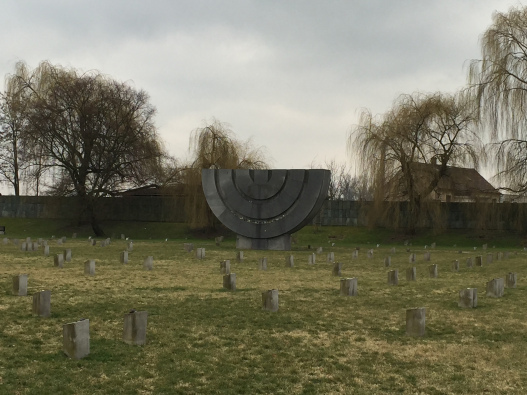
The memorial near the crematorium
Filed under: Holocaust, Memory, Nazi, Theresienstadt, Writing Tagged: Deportation, Poetry








April 9, 2016
On the Way to Terezín
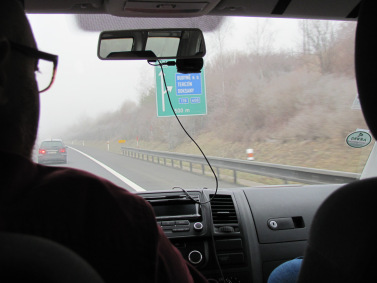
Our guide, Jiri, picked us up at our hotel. After a few minutes of introductions and small talk we climbed into his minivan and headed to Terezín. The drive there from Prague was about 45 minutes, and I used the time to explain to Jiri that my mother and her family were prisoners in Theresienstadt during the war, what I was hoping to find, and that I was working on a book.
The first thing I noticed was the heavy fog along the highway. Jiri told me that this area is known for fog. That’s why mom always describes Theresienstadt as gray. I can add that as a detail in the book somewhere.
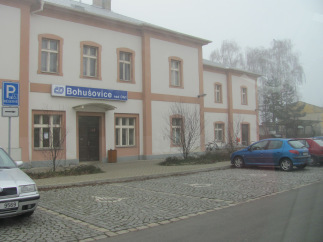
As we approached Terezín, Jiri made a slight detour and brought us to the train station of Bohušovice nad Ohří. This is a small, innocuous looking building. When the camp first started, the Jews who were sold new homes, promised a spa for the elderly, and a beautiful place to settle, were forced to disembark here, and then to Theresienstadt. Later, when they were being shipped to their deaths at Auschwitz, they also had to walk along these streets. Eventually, the Nazis made them build the last three kilometers of track into the camp.
The drive from Bohušovice nad Ohří to Terezín was pleasant with tidy looking homes along the road. I wondered what the local residents did and thought when they saw the tired Jews being herded along their street. Jiri said that they closed their shades and hid. They were afraid of the Germans. They didn’t want to stick their necks out and get shot. They didn’t want to know too much.
Would I have done the same? I hope that I would have done something more — left some food on 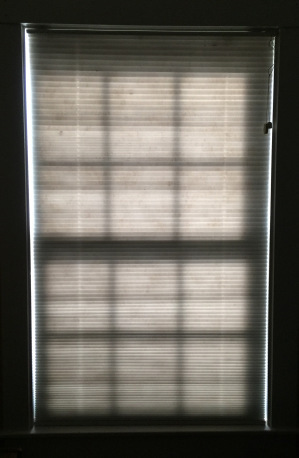 the street or put a sweater by the curb. Maybe I would have called out the window with words of encouragement to let those poor souls know they had a witness. I don’t know. How can anyone say what they would have done in a situation that they didn’t live through?
the street or put a sweater by the curb. Maybe I would have called out the window with words of encouragement to let those poor souls know they had a witness. I don’t know. How can anyone say what they would have done in a situation that they didn’t live through?
And what am I doing now? Am I helping refugees? There are many people in the world being mistreated by governments and immoral regimes. I don’t want to be one of the people hiding in my tidy home behind closed shades.
Filed under: Holocaust, Nazi, Theresienstadt Tagged: Auschwitz, Bohušovice, Deportation, Helping, Ignoring Problems, Kindness, Power of Stories, Refugees, Theresienstadt








March 30, 2016
Kaddish in Prague
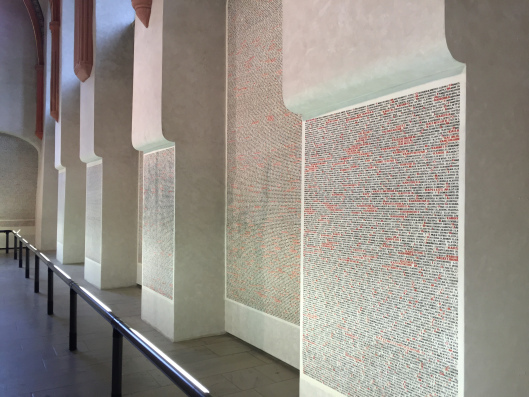 For our second day in Prague I had set up a meeting with one of the archivists at the Jewish Museum. I was hoping that she might have access to some of the primary source material I was looking for.
For our second day in Prague I had set up a meeting with one of the archivists at the Jewish Museum. I was hoping that she might have access to some of the primary source material I was looking for.
According to my great-grandfather’s diary, my grandfather, Heinz, had been told to report for a transport from Theresienstadt to “the east” in October 1944.
During the time span from Sept. 28 till Oct 28, 1944, exactly 30 days, no less than 12 transports with about 25,000 people were deported from here to Poland. During the 3rd transport, Heinz was called up in the evening hours to depart for Poland the following day. We knew that no one could do anything about it and spent a horrible night. The next day Heinz went to the German council, showed them his passport from Paraguay and his name was removed from the list.
One of my goals for this trip was to find out which transport he was supposed to be on and find the list with his name crossed out.
I had some trouble connecting with the archivist when I first arrived at the museum. I was told she was out for the morning because there was a special service at the synagogue to honor the Czech Jews who had been murdered during the Holocaust. This was an opportunity I hadn’t expected, and despite the fact I wasn’t dressed for the occasion, I decided to try to attend the ceremony.
I went to the Pinkus Synagogue with the hope of paying my respects and comparing the service to similar ones I have attended in the U.S. Unfortunately, I couldn’t get past the security guard. I told him I was Jewish. I told him my great-grandfather was from Czechoslovakia and had been imprisoned in two concentration camps. I told him that several of my family members had been murdered during the Holocaust. No dice. As I discussed the situation with him, he let several other people through. I noticed that they didn’t have tickets or any special ID and I asked him how he knew he could let them in, but not me. He said that he knew them.
The Jewish community in Prague is so small that everyone knows everyone else. I stuck out like a sore thumb, and they weren’t going to take any chances. Someone they didn’t know might do something to disrupt the Kaddish or endanger the Prague Jews who would be gathered there today.
Some stark statistics* on the population of Czech Jews:
1921 125,083
1930 117,551
1945 18,000 (over 92,000 perished during WWII)
1970 7,000 (about half the Jewish population fled Communism)
2010 3,900
Today there are only about 1,600 Jews who are members of the Prague Jewish Community.
I politely thanked the guard for his time and went on my way, hoping to catch up with the archivist and visit the historic site later in the day.
I did return to the Pinkus Synagogue (please click on this link to see a virtual tour) that afternoon and was surprised by what I found. I had expected a sanctuary with chairs for congregants and a bema up front with an ark for the Torah. Instead, the synagogue was completely empty except for a more traditional bema in the middle. The walls were white stucco and covered floor to ceiling on every surface of every wall with the names of the Jews that perished during the Holocaust. They are divided into sections by town and then listed alphabetically within each town. You can see that entire villages were wiped out and how many members of one family were lost. I found my mother’s maiden name, and I know the people represented there were my distant relatives.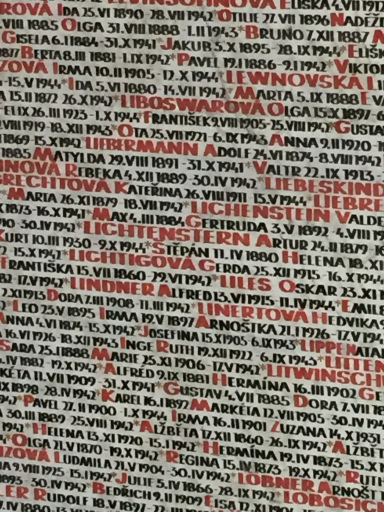
One more stop for the day: to catch up with the archivist. I found her, and we spoke for a while. Unfortunately I had more information to give her than she did to give me. She said that all the documents that they had were already digitalized and on their website. So if I hadn’t found what I was looking for yet, they didn’t have it. She thought I might find it in various archives in Germany.
Before I left, I asked her about the ceremony and why she thought I couldn’t attend. She wasn’t sure. I asked her about current anti-Semitism in the Czech Republic and her answer was telling. “There aren’t enough Jews here for anyone to notice and be anti-Semitic.”
*https://en.wikipedia.org/wiki/History_of_the_Jews_in_the_Czech_Republic http://www.jewishvirtuallibrary.org/jsource/vjw/Prague.html
Filed under: Holocaust, Prejudice, Theresienstadt Tagged: anti-semitism, Antisemitism, Communism, Czech Republic, Czechoslovakia, Jewish community, Kaddish, Mourner's Kaddish, Prague, primary sources








March 24, 2016
Old Jewish Cemetery, Prague
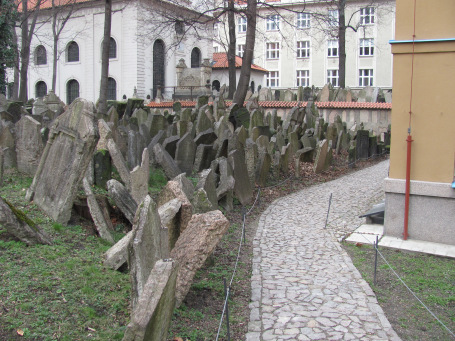 I just returned home after spending two weeks in Europe digging through the last bits of unearthed archives for “Scraps of Hope” research. Over the next several weeks I will share some of what I did and didn’t find.
I just returned home after spending two weeks in Europe digging through the last bits of unearthed archives for “Scraps of Hope” research. Over the next several weeks I will share some of what I did and didn’t find.
Our first stop was Prague. My husband and I spent the first day as tourists exploring the Old Town and the Jewish Quarter. One of our stops was the Old Jewish Cemetery, which is the largest surviving Jewish cemetery in central Europe.
In order to enter we needed to purchase tickets and have them scanned. We passed a couple of security guards who had the right to search us if they felt it was necessary. Then we went up a few stairs and through the open gate of the large stucco wall to see what lay on the other side.
Over the space of about two acres there are more than ten thousand headstones all crammed together leaning every which way. Many are touching back to back or back to front. Some are crumbling with age. Many are moss covered. I saw headstones buried with only a few inches sticking out of the earth. All were inscribed in Hebrew. There was no Czech, German, or other language.
How did this situation develop?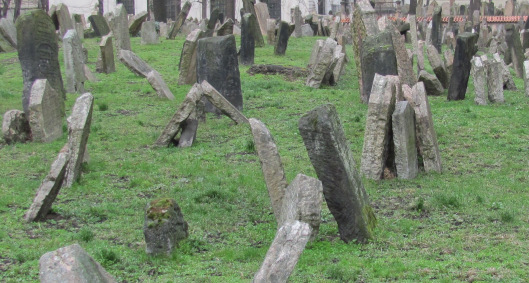
The Jews of Prague buried their dead here from the first half of the 15th century until the late 1700’s. The Jews were only allowed so much space within the city and had to make do with what they had. In order to bury their dead without disturbing older graves, they would heap another layer of soil on top of the older graves and bury their loved ones above the older ancestors. The headstones would then be raised to the new level so they would still be visible. Some areas within the graveyard are twelve layers deep.
Now we are left with this dense patch of gravestones, and I see that the walls I thought were for privacy or protection are really retaining walls needed to hold all the layers of the dead in place.
What did I notice and feel as I walked through this cemetery?
I felt wonder at the beauty of the scene. Moss covered 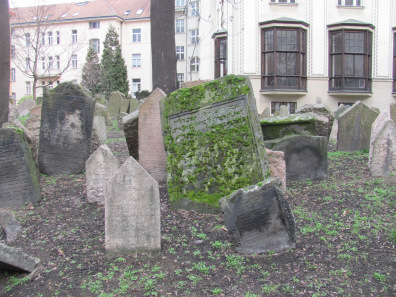 stones – green on gray; trees growing – nourishing themselves with the decomposed bodies of ancient Jews with their roots merging with the headstones and hugging them.
stones – green on gray; trees growing – nourishing themselves with the decomposed bodies of ancient Jews with their roots merging with the headstones and hugging them.
I felt anger at the centuries of forced separation and intolerance by the majority cultures that didn’t allow this community enough room to expand.
I felt awe at the ingenuity of my forefathers to find a way to honor their dead without disturbing the precious graves of those that had passed before.
I felt joy that this spot is being preserved and revered, unlike other Jewish cemeteries in Prague of the 19th and 20th century that the communist regime built over when they wanted to install a housing project.
And I felt disappointed in myself for not thinking to bring a few pebbles to place on these graves to honor these souls.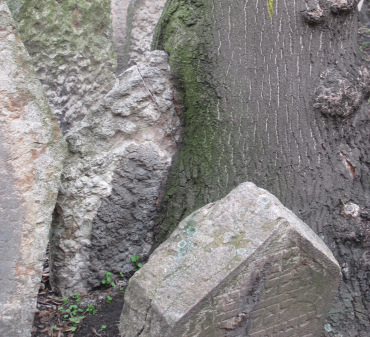
Filed under: Memory, Prejudice, Research Tagged: Antisemitism, Jewish Quarter, Old Jewish Cemetery, Prague, Tourists









